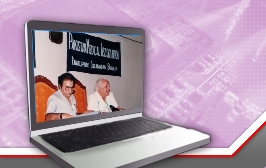| |

Tuesday, August 31, 2010
Throughout his life, Ayub remained purposefully engaged and led a remarkably productive life. Besides his work as a student leader, he will be remembered for his contributions to Urdu literature and to the promotion of Pak-China friendship
Ayub Mirza was among the diverse group of students in Karachi whose serendipitous meeting in post-partition Karachi’s narrowly spread out educational institutions — within an area of about half-a-square mile — led to a vibrant student movement, which later created a historical landmark known as the January 1953 student movement. Along with the movement’s iconic leader, Dr M Sarwar, who passed away in May last year, Ayub Mirza was among the core group of student activists, mainly based in Dow Medical College, who founded the base of the Left movement, firmly rooted among students. Karachi itself was a melting pot, not only because it was the country’s capital, but also because of the influx of refugees from all parts of India, as well as migrations from within Pakistan. Ayub was from Kashmir and probably one of the first Kashmiris I had met — fair and handsome, with a lot of charm and good humour. He was the first Secretary of the Democratic Students’ Federation in Karachi established in 1951. I was studying in the Sindh Muslim College and got to know him through Sarwar and in student meetings in the medical college, which was the centre of students’ activities. I got to know him more closely when in the summer of 1954, along with two score other student and non-student activists, we were arrested for alleged communist activities and sent to appease the US masters as a sacrifice for getting the US aid under the Pak-US military alliance, and spent up to a year in the Karachi Central Jail in the same prison barrack. Ayub’s parents got him released much earlier as a result of political pressures from the Azad Kashmir government. Nonetheless, we got to know each other much more closely than we did previously.
My next encounter — albeit a brief one — was in London where we had both gone to study after getting released from jail and completing our education in college. I met him along with his wife a few months before their first child, Ricky, was born. We occasionally met him along with Eric Rahim, whom we both knew as a journalist working for a leading English daily, who later moved to London to study economics. But our real friendship began when I joined the Islamabad University (now Quaid-e-Azam University) in 1969, by when Ayub had established a successful medical practice in Rawalpindi. I remember meeting him accidentally near Flashman’s Hotel while he was driving to his clinic. He took me to his house in Satellite Town, where I also settled later on with my family. Among our common Karachi acquaintances was also the journalist Ahmad Hasan, who too had a house nearby. Ayub’s house in Satellite Town (and later in Harley Street) became a centre of many gatherings in which Faiz Ahmed Faiz, Khwaja Masud and many other prominent people used to gather and be entertained by the excellent hospitality of himself and his amiable wife, Shireen. Among the many other people who congregated at Ayub’s house were Ahmad Faraz, Khalid Saeed Butt, Munnoo Bhai, Sadeqain and many others. I particularly remember one evening in which Eqbal Ahmad, who was on a brief visit from the US, asked Ayub and Faiz sahib to convey to Prime Minister Bhutto that the greatest threat to the Left was the Jamaat-i-Islami and that he should be careful about the possibility of their infiltration into the military. Unfortunately, he was not taken very seriously then.
Ayub’s medical practice in Banni was a haven for the poor. He was appointed as medical adviser to a number of government and semi-government institutions, including our university, and he was always very kind and helpful to their employees, especially those in the lower grade. I would like to recall a particular episode that illustrates his humanity. One of the Christian sweepers at the university fell ill and asked me to recommend to him a doctor. I told him that Ayub was on the university’s panel and that he should go and visit him. The next day after visiting his clinic, he came and thanked me. He said Ayub was the first doctor to ever touch his body and put the tooti (stethoscope) on his chest.
For more than two decades, we and our families remained close friends and regularly visited each other. Our children grew together. Ayub’s daughter, Alina, and our daughter, Saba, graduated from the Rawalpindi Medical College around the same time. Ayub was harassed during Ziaul Haq’s regime and lost the clientele of most of the government and autonomous bodies. He eventually decided to leave for the UK, visiting Islamabad every year or every other year. About a decade ago, he had a serious stroke travelling on a bus from Lahore to Islamabad. I was shocked to see him in that state. Fortunately, his wife and daughter came and took him back to UK. But he never fully recovered from the stroke. However, he continued to work and wrote two books after that serious illness.
Throughout his life, Ayub remained purposefully engaged and led a remarkably productive life. He was always loyal and generous to his friends. Although primarily a doctor, he achieved much outside his chosen profession. Besides his work as a student leader, he will be remembered for his contributions to Urdu literature and to the promotion of Pak-China friendship.
The writer is a freelance columnist. He can be reached at smnaseem@gmail.com
http://www.dailytimes.com.pk/default.asp?page=2010%5C08%5C31%5Cstory_31-8-2010_pg3_6
|





















